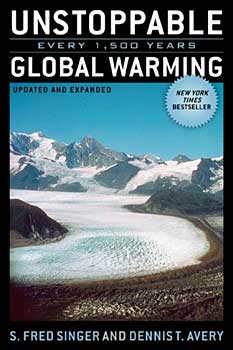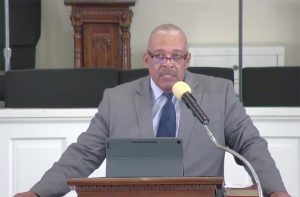A Reexamination of Climate Change Issues
Fraud and Deceit in Selling Man-Made Global Warming (Book excerpts from “Unstoppable Global Warming — Every 1,500 Years”)
This article contains excerpts from the book “Unstoppable Global Warming— Every 1,500 Years” that explain a number of issues related to the global warming scientific community, including why many scientists publish misleading information about climate change, how the UN’s Intergovernmental Panel on Climate Change (IPCC) has published false information claiming certainty of global warming being man-made, and it explains why claims of scientific consensus are not accurate.

Unstoppable Global Warming - Every 1,500 Years by Fred Singer and Dennis Avery. |
“In 1995, I published a short paper in the academic journal Science. In that study, I reviewed how borehole temperature data recorded a warming of about one degree Celsius in North America over the last 100 to 150 years. The week the article appeared, I was contacted by a reporter for National Public Radio. He offered to interview me, but only if I would state that the warming was due to human activity. When I refused to do so, he hung up on me. I had another interesting experience around the time my paper in Science was published. I received an astonishing email from a major researcher in the area of climate change. He said, ‘We have to get rid of the Medieval Warm period.’” — David Deming, University of Oklahoma, before the Senate Environment and Public Works Committee, December 6, 2006 |
A warming of 0.6 degrees C over a century is a very modest bit of “climate change,” given our planet’s highly varied temperature history. Researchers recently cored seven species of long-dead trees that were growing in the year 1350 above the current tree line on California’s Whitewing Mountain (and were killed then by a local volcanic explosion). The researchers say that the tree species and location mean the temperatures then were 3.2 degrees C warmer than today--five times the warming of the 20th century.(258) The Holocene Optimum, 5,000 years ago, was even warmer than the year 1350. Temperatures during ice ages fall 15 degrees C below our current norm. The planet has survived all of these temperature extremes, and so have its wildlife species.
Why has the very modest recent warming trend triggered such widespread calls for radical action, especially in light of the planet’s far more dramatic climate changes in the past? In the first place, scares attract media and public attention, and the environmental movement has become an expert in presenting scares. The scares work especially well then they include guilt—and global warming is the ultimate guilt trip for rich First Worlders: “Your cars and comforts are killing our planet!”
Politicians have always been eager to save us from popular “dangers,” and global warming is no exception. Now scientists, having learned from the professional environmentalists and the politicians just how much money and power a good scare can generate, are stoking a giant grant-making machine with our modest bit of actual warming as the fuel.
THE REAL COST OF GLOBAL WARMING-RESEARCH GRANTS
The U.S. government has recently been spending $2 billion per year on global warming-inspired science grants. A generation ago, that level of spending on such an esoteric subject would have been unthinkable. Today, the public can’t seem to get enough readouts from expensive global climate models issuing ever-more-outlandish climate change projections.
The British government recently funded a report by Sir Nicholas Stern, an advisor to the British government, that predicts financial disaster for the world unless it immediately spends huge amounts of money to eliminate fossil fuels that provide 85 percent of our energy. Bjorn Lomborg, the Danish environmental writer, concluded, “Mr. Stern’s core argument that the price of inaction would be extraordinary and the cost of action modest ... fall[s] apart when one actually reads the 700-page tome. ... [it is] selective and its conclusion flawed. Its fearmongering arguments have been sensationalized ....”(259)
In times past, we could have counted on skeptical scientists to blow the whistle on a fraudulent science scare. Does scientific peer review protect the public from misguided belief in human responsibility for Earth’s natural climate changes? Apparently not. Much of the news about climate change is now being produced by highly qualified scientists, using multimillion-dollar supercomputers to run billion-dollar coupled global circulation models projecting unverified climate guesses a hundred years into the future--where any mistakes will be hugely amplified.
Other scientists are putting up highly sophisticated satellites, running long-range aircraft to monitor atmospheric trends, packing research ships with equipment for voyages to the Antarctic--and writing scary press releases to keep research funds flowing.
Most of the funding to date has gone to atmospheric research, but marine scientists have recently begun demanding their share, claiming that global warming will bring on “abrupt global cooling” by shutting down the ocean’s conveyor currents. Such a shut-down actually happened in the Younger Dryas event 12,500 years ago. The key difference between today and the Younger Dryas is that the Northern Hemisphere is no longer covered with ice sheets a mile thick, which if quickly melted, would produce vast amounts of fresh meltwater. Comparing today with the erratic end of the last Ice Age is scientific deceit, at least.
...
THE "SCIENTIFIC CONSENSUS" MANTRA
It is sheer fantasy to suggest that a huge majority of scientists with expertise in global climate change endorses an alarming interpretation of the recent climate data. In fact, the footnoted studies in this book include hundreds of climate-science authors whose work argues against the alarmist view of climate change. However, the false assertion that there is a "scientific consensus" has played marvelously well in the newspapers and TV programs that have built their circulation and ratings with scary stories about climate change. Indications of dissent in the science community include:
— In 1992, a "Statement of Atmospheric Scientists on Greenhouse Warming" that opposed global controls on greenhouse gas emissions drew about one hundred signatures, mostly from members of technical committees of the American Meteorological Society."(266)
— In 1992 "Heidelberg Appeal," which also expressed skepticism on the urgency of restraining greenhouse gas emissions, drew more then 4,000 signatures from scientists worldwide.(267)
— The 1996 "Leipzig Declaration on Global Climate Change" emerged from an international conference on the greenhouse gas controversy, and was signed by more than one hundred scientists in climate and related fields.(268)
— In 1996, an international survey by Dennis Bray and Hans von Storch of more than four hundred climate scientists found only 10 percent said they "strongly agree" with the statement: "We can say for certain that global warming is a process already underway." Close to half—48 percent--said they didn't have faith in the forecasts of the global climate models.(269)
— A 1997 survey of U.S. State Climatologists (the official climate monitors in each of the fifty states) found 90 percent agreeing that "scientific evidence indicates variations in global temperature are likely to be naturally occurring any cyclical over very long periods of time."(270)
— In 1998, more than 17,000 scientists signed the "Oregon petition," expressing doubt about man-made global warming and opposing the Kyoto Protocol. The petition was hosted by the Oregon Institute for Science and Medicine.(271)
— In 1992 "Heidelberg Appeal," which also expressed skepticism on the urgency of restraining greenhouse gas emissions, drew more then 4,000 signatures from scientists worldwide.(267)
— The 1996 "Leipzig Declaration on Global Climate Change" emerged from an international conference on the greenhouse gas controversy, and was signed by more than one hundred scientists in climate and related fields.(268)
— In 1996, an international survey by Dennis Bray and Hans von Storch of more than four hundred climate scientists found only 10 percent said they "strongly agree" with the statement: "We can say for certain that global warming is a process already underway." Close to half—48 percent--said they didn't have faith in the forecasts of the global climate models.(269)
— A 1997 survey of U.S. State Climatologists (the official climate monitors in each of the fifty states) found 90 percent agreeing that "scientific evidence indicates variations in global temperature are likely to be naturally occurring any cyclical over very long periods of time."(270)
— In 1998, more than 17,000 scientists signed the "Oregon petition," expressing doubt about man-made global warming and opposing the Kyoto Protocol. The petition was hosted by the Oregon Institute for Science and Medicine.(271)
In 2001, the American Association of State Climatologists, issued the following statement:
Climate prediction is complex, with many uncertainties. The AASC recognizes climate prediction is an extremely difficult undertaking. For time scales of a decade or more, understanding the empirical accuracy of such predictions—called "verification"—is simply impossible, since we have to wait a decade or more to assess the accuracy of the forecasts.(272)
— In 2003, Bray and von Storch again surveyed climate scientists around the world. This time the survey found 44 percent disagreed with the statement, "climate change is mostly the result of anthropogenic (man-made) causes," with more climate scientists "strongly disagreeing" than "strongly agreeing" with the statement. Only a third agreed with the statement, "climate models can accurately predict climate conditions in the future," while 18.3 percent were uncertain and nearly half disagreed.(273)
— In 2003, Bray and von Storch again surveyed climate scientists around the world. This time the survey found 44 percent disagreed with the statement, "climate change is mostly the result of anthropogenic (man-made) causes," with more climate scientists "strongly disagreeing" than "strongly agreeing" with the statement. Only a third agreed with the statement, "climate models can accurately predict climate conditions in the future," while 18.3 percent were uncertain and nearly half disagreed.(273)
Man made warming proponents have tried to discredit all opposition, of course. In the case of the Oregon Petition, the detractors got a few fake names added to the petition and then reported them to the media, as if this discredited the thousands of valid names.
On the other hand, a group called Ozone Action, based in Washington, DC, sent President Clinton a "Scientists' Statement on Global Climatic Disruption" in 1997. It claimed to have the signatures of 2,611 scientists from the United States and abroad, endorsing the evidence of man-made global warming as "conclusive." According to Citizens for a Sound Economy (a group opposing climate alarmism) only about 10 percent of the letter's signers had experience in fields connected with climate science. The signers did, in fact, include two landscape architects, ten psychologists, one traditionally trained Chinese doctor, and a gynecologist.(274)
...
The book “Unstoppable Global Warming— Every 1,500 Years,” by Fred Singer and Dennis Avery may be purchased from Amazon.
Article Tree
| A Reexamination of Climate Change Issues |
| Section Directory: Issues with the Science of Global Warming |
| Fraud and Deceit in Selling Man-Made Global Warming (Book excerpts from “Unstoppable Global Warming — Every 1,500 Years”) |
Citations
(258) C.I. Millar, et al., “Late Holocene forest dynamics, volcanism, and climate change at Whitewing Mountain and San Joaquin Ridge, Mono County, Sierra Nevada, CA, USA,” Quarterly Research 66 (2006):273-287.
(259) Bjorn Lomborg, “The dodgy numbers behind the latest warming scare,” OpinionJournal, November 2, 2006.
(266) S. Fred Singer, Hot Talk, Cold Science (Washington DC; Independent Press, 1992):40.
(267) Heidelberg Appeal, released at the 1992 Earth Summit in Rio de Janeiro (accessed 8/5/07)
(268) Text of the Leipzig Declaration on Global Climate Change (accessed 8/5/07)
(269) Dennis Bray and Hans von Storch, “1996 Survey of Climate Scientist on Attitudes toward Global Warming and Related Matters,” Bulletin of the American Meteorological Society 80 (March 1999):439-55.
(270) “Survey of State Experts Casts Doubt on Link between Human Activity and Global Warming,” press release, 1997, Citizens for a Sound Economy, Washington DC
(271) Global Warming Petition, Oregon Institute for Science and Medicine, Cave Junction, Oregon
(272) Policy Statement on Climate Variability and Change, American Association of State Climatologists, approved November 2001.
(273) The survey results were published in 2007 by The Heartland Institute as Joseph L. Bast and James M. Taylor, Scientific Consensus on Global Warming (accessed 8/5/07)
(274) Scientists’ Statement on Global Climatic Disruption, Ozone Action, Washington, DC, 6 June 1997.
(259) Bjorn Lomborg, “The dodgy numbers behind the latest warming scare,” OpinionJournal, November 2, 2006.
(266) S. Fred Singer, Hot Talk, Cold Science (Washington DC; Independent Press, 1992):40.
(267) Heidelberg Appeal, released at the 1992 Earth Summit in Rio de Janeiro
(268) Text of the Leipzig Declaration on Global Climate Change
(269) Dennis Bray and Hans von Storch, “1996 Survey of Climate Scientist on Attitudes toward Global Warming and Related Matters,” Bulletin of the American Meteorological Society 80 (March 1999):439-55.
(270) “Survey of State Experts Casts Doubt on Link between Human Activity and Global Warming,” press release, 1997, Citizens for a Sound Economy, Washington DC
(271) Global Warming Petition, Oregon Institute for Science and Medicine, Cave Junction, Oregon
(272) Policy Statement on Climate Variability and Change, American Association of State Climatologists, approved November 2001.
(273) The survey results were published in 2007 by The Heartland Institute as Joseph L. Bast and James M. Taylor, Scientific Consensus on Global Warming
(274) Scientists’ Statement on Global Climatic Disruption, Ozone Action, Washington, DC, 6 June 1997.








